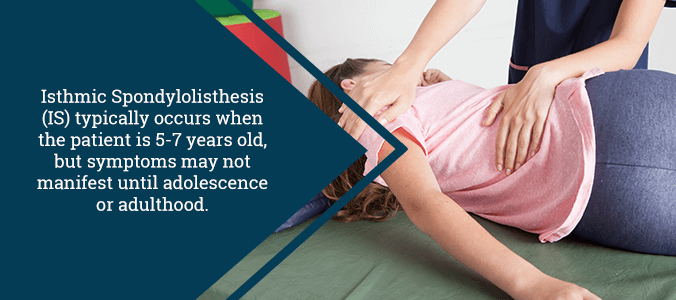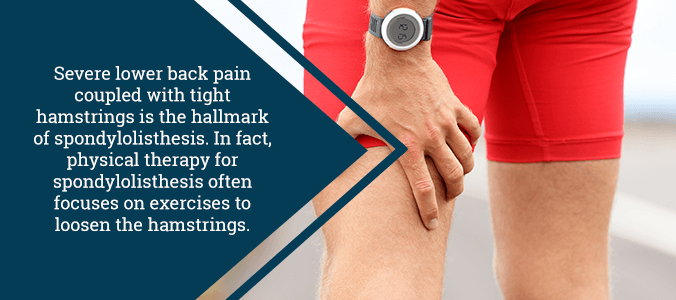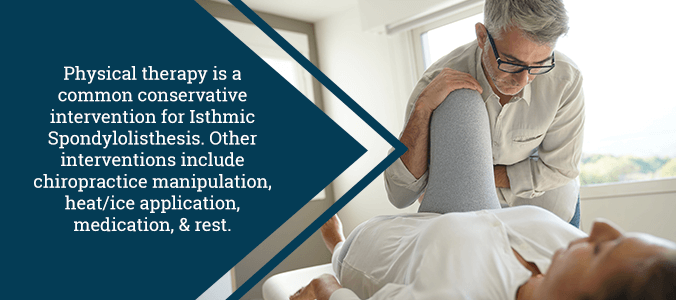Spotting the Signs of Isthmic Spondylolisthesis (IS)
Isthmic Spondylolisthesis (IS) occurs when a vertebral body slips forward, grating on the one below it. Usually, this happens when a piece of bone that connects the two joints on the anterior side fractures. The fracture in this bone, called the pars interarticularis, happens because of stress applied to the bone. Typically, this occurs when the patient is young (5-7 years of age). While this may be, symptoms do not usually manifest until adulthood. There may also be a spike of lower back pain from the condition during adolescence, but it is much more pronounced later in life.
Around 5 – 7% of the population has a fracture in the pars interarticularis or some variant of spondylolisthesis. Additionally, 80% of patients with the condition never even exhibit symptoms. Out of the symptomatic patients, only 15 – 20% will actually need surgery to correct the problem.

Causes of Isthmic Spondylolisthesis (IS)
The pars interarticularis joins the facet joint above to the one below. This bone is very thin and has a poor blood supply, which makes it much more prone to stress fractures than other bones. Medical experts sometimes refer to this bone as the isthmus while spondylolisthesis refers to the fracture itself. Hence, the name isthmic spondylolisthesis.
When the fracture occurs, it does not usually cause immediate pain or other symptoms. Additionally, trauma is not a common cause of this kind of fracture. The fracture typically results from cumulative stress, which happens over a period of time through everyday normal activities. These repeated incidents of micro-pressure will eventually lead to the bone breaking down, causing this condition.
IS most commonly occurs at the L5-S1 level of the spine, otherwise known as the lowest level of the lumbar spine. Of course, this condition may also occur at higher levels in the spine, but this is much rarer. At higher levels, the most common cause of the fracture is trauma.
So far, this condition has not been found in any newborn children, so it is not a congenital issue. The slip resulting from the fracture is most likely to worsen in juvenile or adolescent patients. Progression of the condition in adulthood is not common.
At L5-S1, there is not really an issue of instability with IS, because of the existence of the sacral alar ligament that connects the L5 vertebra to the sacrum. This very large ligament helps to prevent the progression of L5 slippage over the sacrum.
Spondylolisthesis Grades
Doctors measure the severity of each IS case by taking a side view x-ray and then following it up with a grade scaling from 1 to 4. The doctor will determine the percent that the vertebral body slips forward over the lower one.
Here is the normalized list of spondylolisthesis grades:
- Grade 1: 25% or less of the vertebra has slipped forward
- Grade 2: 26%-50%
The vast majority of cases fall under grades 1 and 2. However, it is possible to sustain even worse degrees of slippage:
- Grade 3: 51%-75%
- Grade 4: 76%-100%
In fact, there are even cases in which the L5 vertebral body may slip off the sacrum entirely and into the pelvis. This, however, is very rare. Most of these cases are easily fixable without the need for surgery.
Symptoms of Isthmic Spondylolisthesis (IS)
If patients experience symptoms from IS, they should keep a lookout for:
- A deep ache in the lumbar region of the spine
- Pain that worsens when standing, walking, or any activity that involves bending backward
- Pain that radiates from the buttocks and back of the thighs
- Neurological symptoms such as numbness or tingling in the legs (especially after walking)
- Pain that improves while sitting or reclining
- Pain that radiates below the knee and sometimes to the foot
- Tight hamstrings
This is a general list of symptoms for the most common forms of the condition. There are more symptoms that may manifest with higher grades of IS. For patients with grades 2, 3, or 4, they may experience the following symptoms:
- The patient will seem to have a larger abdomen and shorter trunk than normal
- The patient will have comorbid lordosis and a vertical pelvis
- Because of the tight hamstrings, the patient may have a waddling gait when they walk
In the rarest instances, patients may also develop cauda equina syndrome. If you experience weakness in the legs, altered sensations, and difficulty controlling the bowel/bladder, you may have this accompanying condition. If so, seek emergency medical attention immediately.

Nonsurgical Treatment for Isthmic Spondylolisthesis (IS)
Conservative treatments for adult patients with the condition is similar to that for patients with general lumbar back pain and/or leg pain from other conditions. Treatment may include one or any combination of the following:
- Medication: Doctors commonly prescribe NSAIDs or oral steroids to reduce inflammation in patients with IS or general back pain.
- Physical Therapy: Any doctor will recommend proper stretching techniques, usually starting with hamstring stretching and progressing to other exercises as treatment continues. In particular, the hamstrings should be given special attention at least twice daily to ensure stress alleviation in the lower back. For more details on an efficient exercise program, talk with your doctor/physical therapist.
- Heat/Ice Application: Doctors recommend applying ice for immediate relief from pain or discomfort after an activity that causes these symptoms. On the other side, heat application relaxes the muscles and helps to promote blood flow, leading to a positive healing environment.
- Chiropractic Manipulation: Manual manipulation from osteopathic doctors will help to alleviate pain by mobilizing painful joints.
- Steroid Injections: In the case of severe pain, these injections may prove useful. Epidural injections help to decrease inflammation in the affected area. Your doctor may even inject the IS-associated fracture with lidocaine and steroids. Naturally, if this provides the patient with relief, then it becomes clear that the fracture is the source of the patient’s discomfort. In other words, your doctor may even use this treatment as a diagnostic tool. Additionally, the steroid injection will prove useful when it comes to reducing inflammation in the pars interarticularis, helping to relieve pain.

Surgical Treatment for Isthmic Spondylolisthesis (IS)
Conservative treatments will usually prevail, but there are certainly cases in which surgery is necessary. Your doctor will always exhaust nonsurgical methods before reaching this stage, however.
Spinal fusion surgery for IS proves to be quite effective, but it is a large procedure that requires a long recovery period. Because of this fact, your doctor will not usually consider this option unless you have failed to find relief for your symptoms within at least six months of nonsurgical treatments.
Posterior fusion with pedicle screw instrumentation is the most common form of lumbar spinal fusion. Your surgeon may also recommend that a frontal spinal fusion is performed at the same time. Whatever your surgeon decides to go with will, of course, depend on their preference and level of experience, as well as the specifics of your case.
Contact Us
If you are experiencing any of the symptoms listed above, please contact us at (855) 220-5966. Dr. Jason E. Lowenstein is a leading expert in the field of spinal deformity care. He is passionate about finding a treatment plan that will suit your specific needs. Don’t hesitate to contact our team of patient advocates today and receive the care that you deserve for your condition!
